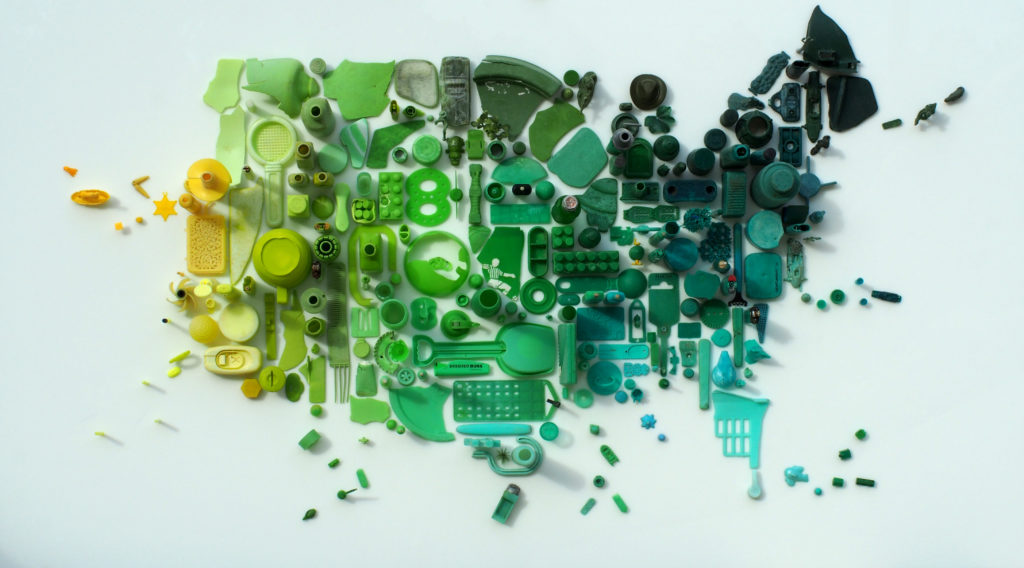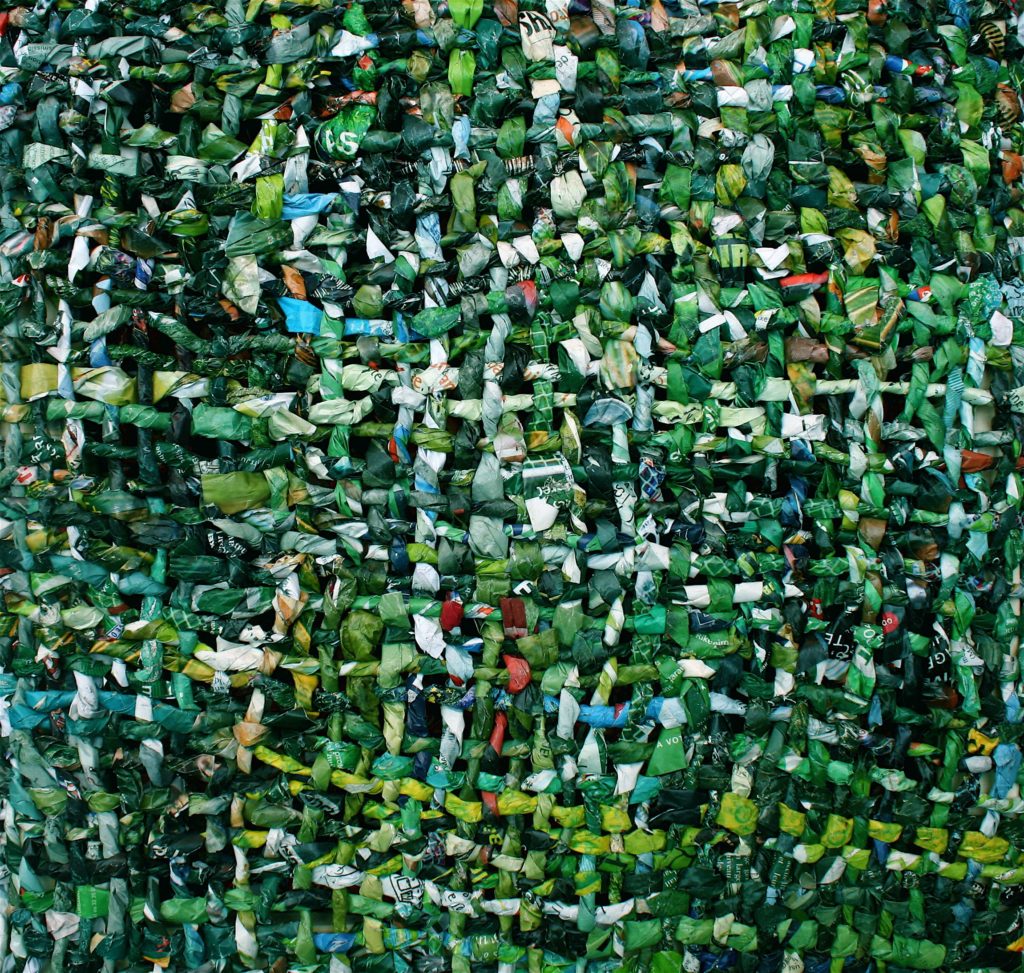
This is part of our special feature, Confronting Waste.
As artists of Objet Trouvé, Gilles Cenazandotti, ziREjA and COHCO-LG explore the materiality of culture and our relationship with surplus objects in the context of an exacerbated consumer ethos. They find creative inspiration in the refuses of contemporary societies, critically transforming waste into a medium for self-expression while simultaneously using it to translate a collective urgency in front of pollution, contamination, destruction, neglect, and the general meaninglessness of things. Their “artivism” is a story of recycling and survival through spatial and temporal aesthetic engagement, which aims at raising awareness about waste, changes perceptions of trashscapes, and mobilizes viewers into becoming participants in the seeking of solutions. By repurposing waste and reclaiming it, so it acquires value again through visual encounter, these artists in effect rethink and rescale waste to place it at the center of socio-political debates. As they reconceptualize waste in their respective compositions—Cenazandotti through assemblages of disparate objects sharing a common history and geography of careless abandonment, ziREjA through photographs highlighting the vastness of emerging dehumanized landscapes of obsolescence, and COHCO-LG through the original interlacing of banal traces of daily life—the scavenger-artists showcased here not only modify the status of waste, but also brace a pedagogical movement vital to the subsistence of the planet and all living organisms inhabiting it. At the current rate at which ecosystems everywhere are being violently disrupted by the rejects of modernity, affording found objects a second chance works as one way to warn that we may have entered the era of Earth’s last chance. Together, the three different artistic approaches below should rally us into preventive action.
–Hélène B. Ducros for EuropeNow
Gilles Cenazandotti
This art is derived out of reclaimed material collected on Mediterranean beaches. Cenazandotti’s three-dimensional collages convey an urgency in the face of ecological degradation and material waste resulting from over-consumption and unbridled disposal of material goods, mostly non-biodegradable fossil-based polymers. By heightening public awareness, this activist beachcomber’s scrap plastic art stands as an encouragement to steward the environment at various scales and to take responsibility for the species that depend on it, including humans. His ordered arrangements, showing gradual transitions between different monochromatic moments within the same oeuvres, translate a systematic and methodical exploration of the nature-society nexus while also activating an emotional response through the aesthetization of familiar yet no longer wanted objects. Here a rubber toy, over there an old jelly shoe or the carcass of a rotary dial phone, all artifacts with disconnected past lives, but that are brought together through color to tell our story of collective neglect towards the environment.



The artist and designer Gilles Cenazandotti is a native of Corsica. After having traveled the world, he returned to the island in order to devote himself to his work as a sculptor out of his workshop located in Morsiglia in Cap Corse. His creations are the expression of the excesses of consumption. He developed his artistic practice through personal growth, as well as through his collaboration with prominent fashion designers and brands such as Jean-Paul Gaultier or Hermès and interior designers such as Philippe Starck. His ecological sensibility is translated not only in the medium he has chosen—objects washed away on coast lines—but the creations themselves, for example his series on endangered species that was featured by Tahoe Public Art in 2017.
ziREja
The art series Accumulation by ziREja shows massive consumption-induced waste, but it does so through an aesthetization of shapes and patterns, as well as the saturation of the colors of waste material and garbage. The photography series also conveys the compressing of the objects, of the garbage, of our thoughts about consumption.



ziREjA is an award-winning photographer and performance artist, based in Tenerife. Through multidisciplinary activist art projects she tackles socio-political issues surrounding the environment, mass consumption, climate change and gender. ziREjA began her career as a professional actress and dancer, performing in the theater. She then translated the concept of using her body as a tool for social change into contemporary art. As part of her environmental photography work, she has reformed found objects of waste, recycling them through the powerful aesthetic of trash art. In 2013 she received an award from the European Environment Agency for “The Waste Coast” about the harmful waste collecting on the shores of places like Spain. ziREjA is co-founder of the collaborative art project “Acción Experimental”, which provides an experimental space for artists who value the body as a tool of action. She set up the group “¡Qué te performen!”, performing with them in “OverExposed”, a show exploring overexposure to new technologies, in the Auditorio de Tenerife and TEA space of the Arts. She has also developed a collaborative and pioneering art project with other artists and TEA Space of the Arts that will bring contemporary art to public schools on Tenerife, breaking down the traditional boundaries between children, museums and art.
Cohco-lg
COHCO-LG is interested in chromatic wefts, which she creates with material she salvages. She explores wefts as she reinvents them in space, using magazine pages, newspapers, plastic bags, or other materials she twists, intertwines, tightens, stretches, and glues to give them a second chance as if she were a sculptor. As she weaves each weft, letters, words and colors meet, organize and get transformed to create a new vibrant surface, new transparencies, new rhythms and new articulations. By adding pigments to highlight certain areas, she plays with colors and shadows to give the material a new identity and energy. She sees the weft as the harmonious intersection of Yin and Yang, with vertical lines symbolizing heat, strength, activity and life, while horizontal lines represent humidity, cold, passivity and death.



COHCO-LG studied art in Paris and lives in France. She has been creating wefts with salvaged material since the early 1990s. Her work has been featured in numerous art shows and galleries in France and other countries, as well as fairs and exhibitions focusing on the intersection of art with sustainable development and recycling strategies.
Hélène B. Ducros is Chair of Research and Pedagogy at EuropeNow. She holds a JD (Law) and PhD in human geography from the University of North Carolina-Chapel Hill. Looking at cultural landscapes historically, she has been interested in wastes and vestiges as cultural objects and traces left behind. Through her travels around the world, she has been fascinated by creative reuse, recycling, upcycling, whether functional or artistic, and interested in exploring people’s inventiveness at giving materials renewed meanings. At UNC-Wilmington, she created and designed the interdisciplinary course on “Global Garbage, Trash, and Solid Waste.”
For more Trash Art in EuropeNow’s past features, visit Indefinite Toxic Circles, It Dwells Within, and Beauty and Waste.
Published on May 7, 2019.




